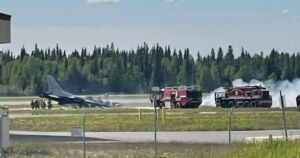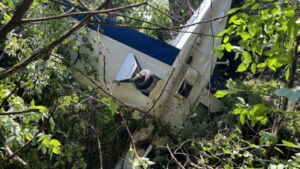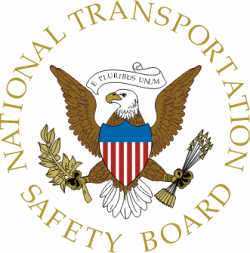Here are the stories for today...
Be safe out there!
Tom
South Korean fighter jet crashes during US-led drill in Alaska
Both pilots survive as KF-16 accident raises new concerns over military flight safety
By Yang Ji-ho, Park Su-hyeon
A South Korean Air Force fighter jet crashed during a training exercise in Alaska, military officials confirmed on June 11, in an incident that has renewed concerns over aviation safety within South Korea’s armed forces.
during a training exercise in Alaska, military officials confirmed on June 11, in an incident that has renewed concerns over aviation safety within South Korea’s armed forces.
The KF-16 jet, a domestically manufactured version of the American F-16, was participating in Red Flag-Alaska, a multinational air combat drill hosted by the United States Pacific Air Forces. According to the South Korean Air Force, the aircraft was taking off from Eielson Air Force Base when an emergency forced both pilots to eject.
The two pilots survived and were transported to a nearby hospital, the Air Force said in a statement to reporters. Their conditions were not immediately disclosed.
Preliminary reports suggest the malfunction occurred just after the aircraft’s landing gear lifted off the runway. The jet, a two-seat model, was preparing for a scheduled sortie at the time of the incident.
Red Flag-Alaska is a recurring joint exercise involving combat aircraft and personnel from multiple allied nations. This year’s drill includes 11 aircraft and about 100 service members from South Korea, including KF-16 fighter jets and KC-330 aerial refueling tankers. The main phase of the exercise is scheduled to begin on June 16, following several days of local acclimation flights. The crash occurred during one of those initial training missions.
“Takeoff and landing are when fighter jets are most vulnerable to accidents,” a South Korean military official said, speaking on condition of anonymity. “That the pilots survived speaks to the strength of their training.”
The incident marks the tenth recorded crash of a KF-16 since the aircraft was introduced in South Korea in the 1990s under license from Lockheed Martin. It also brings the total number of South Korean military aircraft incidents this year to five, including two previous KF-16-related accidents in March and April.
https://www.chosun.com/english/national-en/2025/06/11/EENEWRLJ6ZDF7MSMBQM42QNYNE/
Small plane crashes in wooded area of Murfreesboro, police say
FOX13 Memphis News Staff
MURFREESBORO, Tenn. - A small plane crashed in a wooded area of Murfreesboro, Tennessee, Tuesday afternoon, according to the Murfreesboro Police Department (MPD).
crashed in a wooded area of Murfreesboro, Tennessee, Tuesday afternoon, according to the Murfreesboro Police Department (MPD).
MPD reported the plane crash around noon. According to police, the crash happened in the woods near Clark Boulevard.
Three people were onboard the plane at the time of the crash, police said. They were all taken to the hospital in stable condition. MPD said the plane was passing through the Murfreesboro area at the time of the crash.
The FAA will investigate the circumstances that led to the plane crashing. A photo shared by police shows the plane submerged in trees.
https://www.fox13memphis.com/news/small-plane-crashes-in-wooded-area-of-murfreesboro-police-say/article_31537dac-9c44-4862-8179-2ae9405de7af.html
NTSB Final Report: Bellanca 17-31ATC
Maintenance Personnel’s Improper Installation Of An Engine-Driven Vacuum Pump
Location: El Cajon, California Accident Number: WPR24LA135
Date & Time: April 28, 2024, 18:15 Local Registration: N8800V
Aircraft: Bellanca 17-31ATC Aircraft Damage: Substantial
Defining Event: Loss of engine power (total) Injuries: 1 Minor
Flight Conducted Under: Part 91: General aviation - Personal
Analysis: The pilot was conducting a test flight following the completion of an annual inspection. During the takeoff climb, the pilot observed an abnormal oil pressure indication and elected to return to the airport. While returning to the airport, the engine sustained a complete loss of oil pressure followed by a loss of all power. Unable to maintain altitude, the pilot elected to make an off-airport landing to a nearby road. During the landing, the airplane struck a power line and a utility pole before it impacted the ground and came to rest upright.
A serviceable engine-driven vacuum pump had been installed on the airplane about 25 days before the accident by a mechanic trainee. After the installation, an engine test ground run was completed and the airplane was returned to service. A mechanic with airframe, powerplant, and inspection authorization (A&P IA) was present but did not verify that the engine-driven vacuum pump had been properly installed or set to any specific torque value. Postaccident examination of the engine revealed a crack in the engine case between cylinder Nos. 5 and 6, as well as no presence of oil in the oil sump. Internal thermal discoloration and damage identified during the engine teardown were consistent with lubrication deprivation.
Additionally, the engine-driven vacuum pump remained attached to but not secured to its mounting pad. All four of the mounting studs were loose, which allowed for forward and aft movement, or “play,” in the vacuum pump of about 1/8 inch with minimal resistance. The vacuum pump accessory mounting pad has a drilled passage that can supply pressurized lubricating oil. In the accident installation, this oil passage was blocked off by mechanical clamping force and a gasket. Absent sufficient clamping force, the oil would leak out until the oil sump is depleted of oil.
Probable Cause and Findings: The National Transportation Safety Board determines the probable cause(s) of this accident to be -- Maintenance personnel’s improper installation of an engine-driven vacuum pump, which resulted in oil starvation to the engine and a subsequent total loss of engine power.
Contributing to the accident was the A&P IA’s lack of supervision.
FMI: www.ntsb.gov

Today in History
36 Years ago today: On 11 June 1989 Scenic Air Tours flight 21, a Beech H18, crashed in a canyon during a sightseeing flight in Hawaii, killing all 11 on board.
| Date: | Sunday 11 June 1989 |
| Time: | 13:30 |
| Type: | Beechcraft H18 |
| Owner/operator: | Scenic Air Tours |
| Registration: | N34AP |
| MSN: | BA-746 |
| Total airframe hrs: | 19864 hours |
| Engine model: | P&W R-985-AN-14B |
| Fatalities: | Fatalities: 11 / Occupants: 11 |
| Other fatalities: | 0 |
| Aircraft damage: | Destroyed |
| Category: | Accident |
| Location: | Waipio Valley, HI - United States of America |
| Phase: | En route |
| Nature: | Passenger - Non-Scheduled/charter/Air Taxi |
| Departure airport: | Hilo, HI (ITO) |
| Destination airport: | Kahului, HI |
| Investigating agency: | NTSB |
| Confidence Rating: | Accident investigation report completed and information captured |
Narrative:
Scenic Air Tours flight 21, a Beech H18, crashed in a canyon during a sightseeing flight in Hawaii, killing all 11 on board.
Flight 21 was on an air taxi, sightseeing flight from Hilo to Kahului, Hawaii. The pilot took off at aprx 1300 HST. After takeoff, flight 21 proceeded along the coastline at an altitude of about 2000 ft. The aircraft subsequently crashed in a scenic canyon area near a waterfall in Waipio Valley, aprx 50 mi NE of Hilo. Impact occurred at an elevation of about 2800 ft, aprx 600 to 900 ft below the rim.
A passenger, who was on a previous sightseeing flight, reported the pilot had manuevered below the rim of a canyon. Company officials reported that flying below rims of canyons was against company policy; however, the operations manual did not contain any guidance or cautions about such operations.
Cause: the pilot's improper in-flight planning/decision to maneuver with insufficient altitude over or in a a canyon area.
Factors related to the accident were: the terrain conditions and scenic air tour's lack of specific direction to its pilots concerning safety procedures for sightseeing flights.
